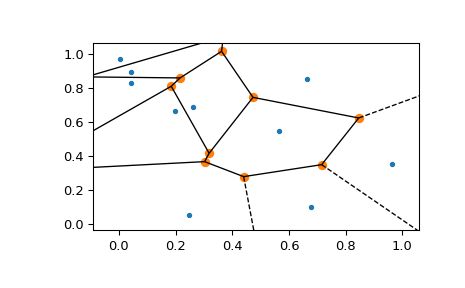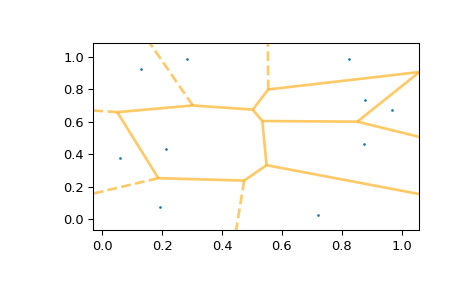voronoi_plot_2d#
- scipy.spatial.voronoi_plot_2d(vor, ax=None, **kw)[source]#
Plot the given Voronoi diagram in 2-D
- Parameters:
- vorscipy.spatial.Voronoi instance
Diagram to plot
- axmatplotlib.axes.Axes instance, optional
Axes to plot on
- show_pointsbool, optional
Add the Voronoi points to the plot.
- show_verticesbool, optional
Add the Voronoi vertices to the plot.
- line_colorsstring, optional
Specifies the line color for polygon boundaries
- line_widthfloat, optional
Specifies the line width for polygon boundaries
- line_alphafloat, optional
Specifies the line alpha for polygon boundaries
- point_sizefloat, optional
Specifies the size of points
- Returns:
- figmatplotlib.figure.Figure instance
Figure for the plot
See also
Notes
Requires Matplotlib. For degenerate input, including collinearity and other violations of general position, it may be preferable to calculate the Voronoi diagram with Qhull options
QJfor random joggling, orQtto enforce triangulated output. Otherwise, some Voronoi regions may not be visible.Examples
>>> import numpy as np >>> import matplotlib.pyplot as plt >>> from scipy.spatial import Voronoi, voronoi_plot_2d
Create a set of points for the example:
>>> rng = np.random.default_rng() >>> points = rng.random((10,2))
Generate the Voronoi diagram for the points:
>>> vor = Voronoi(points)
Use
voronoi_plot_2dto plot the diagram:>>> fig = voronoi_plot_2d(vor)
Use
voronoi_plot_2dto plot the diagram again, with some settings customized:>>> fig = voronoi_plot_2d(vor, show_vertices=False, line_colors='orange', ... line_width=2, line_alpha=0.6, point_size=2) >>> plt.show()

